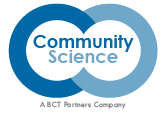2017 marks the 20th anniversary of the founding of Community Science, originally known as the Association for the Study and Development of Community (ASDC). ASDC emerged as a place where social change professionals could come to focus on “creating healthy, just, and equitable communities.” The promotion of healthy, just, and equitable communities has been a central part of Community Science from the very first day. Kien Lee joined me in forming ASDC, first in a small study in my home and then graduating into our basement. We grew to five people in our basement—to the dismay of our children. When my wife would bake cookies and other treats for our young children, staff would get a whiff of her cooking and instant message me to see if I could bring anything down for them to eat.
Our first projects were evaluating the social development components of LISC’s Community Building Initiative, a learning process for community foundations to build their capacity to improve intergroup relations with long-term residents and newcomers, and developing a measure of Strength of Tobacco Control for the National Cancer Institute.
Today, we have 20 employees and are still growing. Community Science has an international reputation for conducting research, evaluation, and capacity building that is rigorously derived and easy to practically apply. We provide a wide range of research and capacity-building services under the leadership of our nationally recognized senior staff. Community Science has had projects all around the world and in nearly every state in the U.S. Our work has expanded in the areas of community and system change, health and other forms of equity, juvenile justice systems, immigrant integration, evaluation capacity building, and most recently, data science, particularly in the use of machine learning. Community Science sees that new technologies, such as data science, and new ways of thinking, such as systems approaches, along with a clear focus on issues of equity and social justice, will guide us through the next years. Oh, and we still have chocolate and other treats in our break room. Some things don’t change.
Community Science and its award-winning work was made possible by many people who work with us as colleagues over the years as well as clients and others who supported us in our unique mission, our steadfast commitment to integrity, and our passion for justice. This is not an easy path for a for-profit social enterprise in the professional services industry. We have been in active pursuit of diversifying the field of evaluation and community capacity building. At Community Science, our leaders have been recognized for our central role in the establishment of the American Evaluation Association’s diversity programs (Graduate Education Diversity Initiative and minority student travel grant program). Our staff has always been made up of a large majority of people of color—a characteristic that reflects both our appreciation for how diversity builds our capacity as well as our commitment to increase diversity in our profession.
Not only do I want to take this chance to recognize Community Science staff, clients, and other supporters (e.g., consultants and professional services corporations), but also the many people who have influenced our intellectual and philosophical growth over the years that has led to our current identity as Community Science. We will be recognizing these key influencers in every issue of The Change Agent in 2017. The first person you want to recognize for his contributions is Ricardo Millett. Ricardo has been a client, always a quintessential colleague, and a current member of the Community Science community.
Everyone who has ever worked at Community Science has agreed that we have been able to attract the most interesting, complex, and socially relevant projects. Given these times, we want to be known going forward as an organization that helped bring justice and equity to America again. Community Science has developed its Strengthened Communities approach and will be unveiling it over the next couple of months. We recognize that in order for there to be justice and equity, people have to care for other people—not just their immediate community. Bonding within communities and bridging across communities are essential. If people care about each other, then they want to see them treated fairly (equitably). Communities need the capacity to bring about sustainable change. Not only do communities need the capacity to strengthen their sense of community within and among neighborhoods, towns, other residential areas, but they also must have the capacity to organize and take collective action to address environmental conditions that promote inequities and poor well-being. Institutions must be able to work together so that there are adequate health, housing, education, safety, and economic opportunities for all residents. This is where we are going. I hope you will join us.
